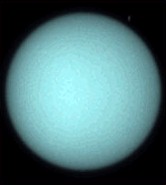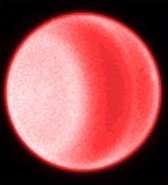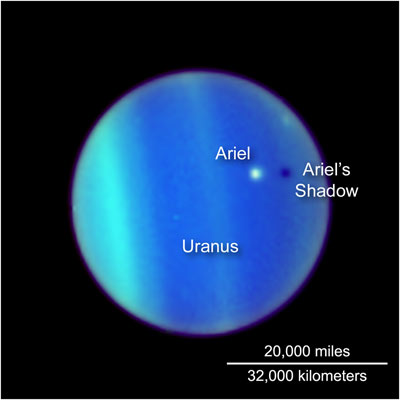 |
 |
 |
 |
Photo No.: STScI-PRC97-36b
November 20, 1997
Using visible light, astronomers for the first time this century have detected clouds in the
northern hemisphere of Uranus. The newest images, taken July 31 and Aug. 1, 1997 with NASA
Hubble Space Telescope's Wide Field and Planetary Camera 2, show banded structure and multiple
clouds. Using these images, Dr. Heidi Hammel (Massachusetts Institute of Technology) and
colleagues Wes Lockwood (Lowell Observatory) and Kathy Rages (NASA Ames Research Center) plan
to measure the wind speeds in the northern hemisphere for the first time.
Uranus is sometimes called the "sideways" planet, because its rotation axis is tipped more than 90 degrees from the planet's orbit around the Sun. The "year" on Uranus lasts 84 Earth years, which creates extremely long seasons - winter in the northern hemisphere has lasted for nearly 20 years. Uranus has also been called bland and boring, because no clouds have been detectable in ground-based images of the planet. Even to the cameras of the Voyager spacecraft in 1986, Uranus presented a nearly uniform blank disk, and discrete clouds were detectable only in the southern hemisphere. Voyager flew over the planet's cloud tops near the dead of northern winter (when the northern hemisphere was completely shrouded in darkness).
Spring has finally come to the northern hemisphere of Uranus. The newest images, both the visible-wavelength ones described here and those taken a few days earlier with the Near Infrared and Multi-Object Spectrometer (NICMOS) by Erich Karkoschka (University of Arizona), show a planet with banded structure and detectable clouds.
Two images are shown here. The "aqua" image (on the left) is taken at 5,470 Angstroms, which is near the human eye's peak response to wavelength. Color has been added to the image to show what a person on a spacecraft near Uranus might see. Little structure is evident at this wavelength, though with image-processing techniques, a small cloud can be seen near the planet's northern limb (rightmost edge). The "red" image (on the right) is taken at 6,190 Angstroms, and is sensitive to absorption by methane molecules in the planet's atmosphere. The banded structure of Uranus is evident, and the small cloud near the northern limb is now visible.
Scientists are expecting that the discrete clouds and banded structure may become even more pronounced as Uranus continues in its slow pace around the Sun. "Some parts of Uranus haven't seen the Sun in decades", says Dr. Hammel, "and historical records suggest that we may see the development of more banded structure and patchy clouds as the planet's year progresses".
Some scientists have speculated that the winds of Uranus are not symmetric around the planet's equator, but no clouds were visible to test those theories. The new data will provide the opportunity to measure the northern winds. Hammel and colleagues expect to have results soon.
Credits:
Heidi Hammel (Massachusetts Institute of Technology)
and NASA
 |
 |
Photo No.: STScI-PRC97-36a
November 20, 1997
Taking its first peek at Uranus, NASA Hubble Space Telescope's Near Infrared Camera and
Multi-Object Spectrometer (NICMOS) has detected six distinct clouds in images taken July 28,
1997.
The image on the right, taken 90 minutes after the left-hand image, shows the planet's rotation. Each image is a composite of three near-infrared images. They are called false-color images because the human eye cannot detect infrared light. Therefore, colors corresponding to visible light were assigned to the images. (The wavelengths for the "blue", "green", and "red" exposures are 1.1, 1.6, and 1.9 micrometers, respectively).
At visible and near-infrared light, sunlight is reflected from hazes and clouds in the atmosphere of Uranus. However, at near-infrared light, absorption by gases in the Uranian atmosphere limits the view to different altitudes, causing intense contrasts and colors.
In these images, the blue exposure probes the deepest atmospheric levels. A blue color indicates clear atmospheric conditions, prevalent at mid-latitudes near the center of the disk. The green exposure is sensitive to absorption by methane gas, indicating a clear atmosphere; but in hazy atmospheric regions, the green color is seen because sunlight is reflected back before it is absorbed. The green color around the south pole (marked by "+") shows a strong local haze. The red exposure reveals absorption by hydrogen, the most abundant gas in the atmosphere of Uranus. Most sunlight shows patches of haze high in the atmosphere. A red color near the limb (edge) of the disk indicates the presence of a high-altitude haze. The purple color to the right of the equator also suggests haze high in the atmosphere with a clear atmosphere below.
The five clouds visible near the right limb rotated counterclockwise during the time between both images. They reach high into the atmosphere, as indicated by their red color. Features of such high contrast have never been seen before on Uranus. The clouds are almost as large as continents on Earth, such as Europe. Another cloud (which barely can be seen) rotated along the path shown by the white arrow. It is located at lower altitudes, as indicated by its green color.
The rings of Uranus are extremely faint in visible light but quite prominent in the near infrared. The brightest ring, the epsilon ring, has a variable width around its circumference. Its widest and thus brightest part is at the top in this image. Two fainter, inner rings are visible next to the epsilon ring.
Eight of the 10 small Uranian satellites, discovered by Voyager 2, can be seen in both images. Their sizes range from about 25 miles (40 kilometers) for Bianca to 100 miles (150 kilometers) for Puck. The smallest of these satellites have not been detected since the departure of Voyager 2 from Uranus in 1986. These eight satellites revolve around Uranus in less than a day. The inner ones are faster than the outer ones. Their motion in the 90 minutes between both images is marked in the right panel. The area outside the rings was slightly enhanced in brightness to improve the visibility of these faint satellites.
Credits: Erich Karkoschka (University of Arizona)
and NASA
For higher resolution pictures, link to
Hubble Watches Uranus
(at the Web site of the STScI).

STScI-2006-42
August 31, 2006
This NASA Hubble Space Telescope image is a never-before-seen
astronomical alignment of a moon traversing the face of Uranus, and its accompanying shadow.
The white dot near the center of Uranus' blue-green disk is the icy moon Ariel.
The 700-mile-diameter satellite is casting a shadow onto the cloud tops of Uranus.
To an observer on Uranus, this would appear as a solar eclipse,
where the moon briefly blocks out the Sun as its shadow races across Uranus's cloud tops.
Though such "transits" by moons across the disks of their parents are commonplace for some other gas giant planets,
such as Jupiter,
the satellites of Uranus orbit the planet in such a way that they rarely cast shadows on the planet's surface.
Uranus is tilted so that its spin axis lies nearly in its orbital plane.
The planet is essentially tipped over on its side.
The moons of Uranus orbit the planet above the equator, so their paths align edge-on to the Sun only every 42 years.
This color composite image was created from images at three wavelengths in near infrared light
obtained with Hubble's Advanced Camera for Surveys on July 26, 2006.
For higher resolution pictures, link to
Hubble Captures a Rare Eclipse on Uranus
(at the Web site of the STScI).
See also Observatorio ARVAL: Solar System Data y ARVAL - Classic Satellites of the Solar System
![]() Updated: August 31 '06
Updated: August 31 '06
Best seen with MS Internet Explorer.
Back to: ARVAL's Gallery (Clouds in Uranus)